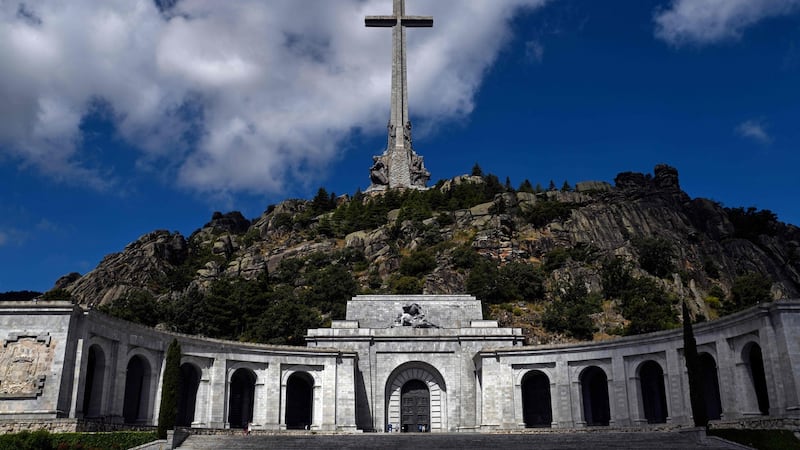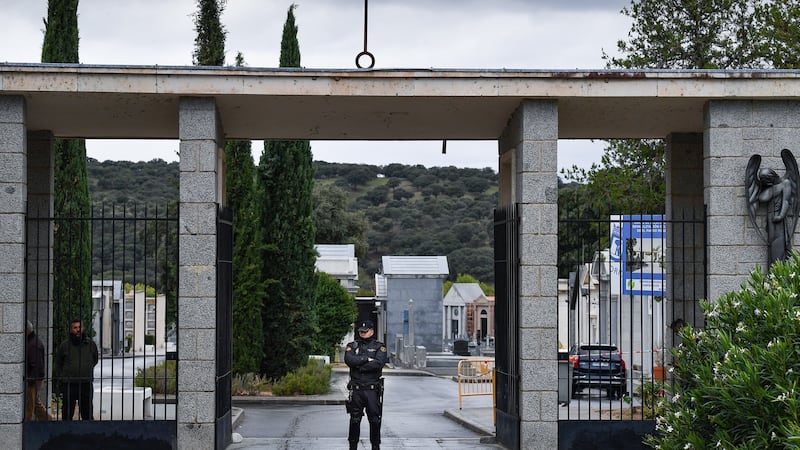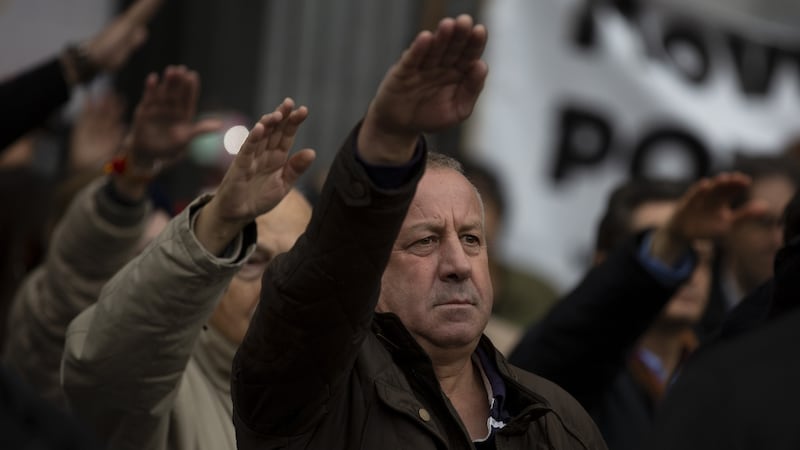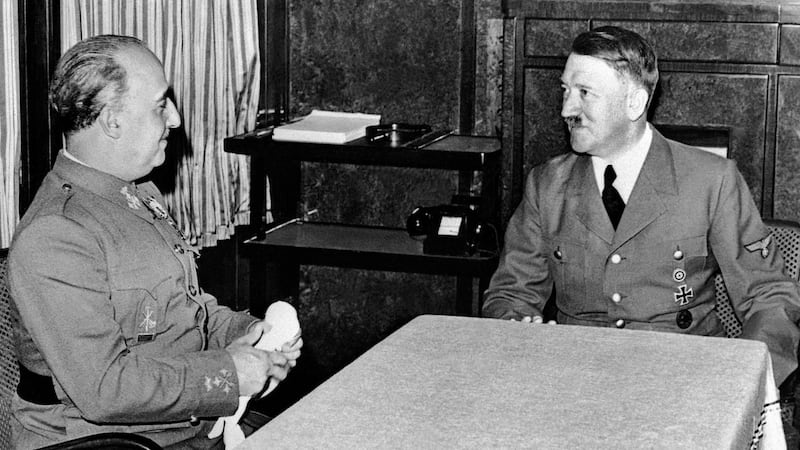To reach the Valley of the Fallen, you drive up a steep, winding road through a pine forest 60km northwest of Madrid. It’s an idyllic spot, offering a glimpse of the Guadarrama mountains and a commanding view of the wooded valley below. It is only when you are at the site itself that its significance starts to become apparent, lending it a sinister edge.
A 150m-high stone cross – the largest in the world – is the monument’s most recognisable feature. At its foot, a huge esplanade stretches out either side, as if designed to hold thousands of troops. Behind it, on the facade of a basilica drilled deep into the mountain, religious imagery combines with the shield-and-eagle symbol of the Franco dictatorship.

Francisco Franco died in 1975, but this place has helped keep him alive in the minds of Spaniards. He was buried at the far end of the basilica, next to another hero of the far-right, founder of the Falange party José Antonio Primo de Rivera. The Valley of the Fallen has long been seen as the most important, and by far the largest, reminder of Franco and one which glorifies his legacy in a way that outrages many Spaniards.
On Thursday, his remains were exhumed from the site and flown in a helicopter to Mingorrubio cemetery just outside Madrid, where his widow is also buried. They were reburied in the presence of his grandchildren and great-grandchildren.
The Socialist acting prime minister Pedro Sánchez, whose government led the exhumation initiative, has said the move “closes a dark chapter of our history”.
Brutal reprisals against Republicans continued after the civil war, with at least 20,000 shot after it ended and tens of thousands more dying in concentration camps and prisons
“No enemy of our democracy deserves a place of worship or of institutional respect,” he said. “This is a great victory for Spanish democracy.”
Sánchez made the exhumation a priority for his administration on taking office in June of 2018. But the fact it has taken 16 months to carry out what was a fairly straightforward logistical process reflects how Franco continues to present Spain with a political and cultural conundrum, 44 years after his death.
Spanish civil war
Franco took power in 1939, at the end of a three-year civil war in which his Nationalist forces, having risen up in a coup d’état, defeated those of the elected leftist Republican government. He ruled as a dictator until his death, in a regime which used so-called National Catholicism as its ideology, a Spanish variant on Italy’s fascism.
“We have to create the impression of mastery, eliminating without scruples or hesitation all those who do not think as we do,” said one of Franco’s generals, summarising his philosophy.
Brutal reprisals against Republicans continued after the civil war, with at least 20,000 shot after it ended and tens of thousands more dying in concentration camps and prisons, according to the historian Paul Preston.
Franco had the Valley of the Fallen built between 1940 and 1959 in theory as a place of reconciliation for the two sides in the civil war. About 34,000 Republican and Nationalist casualties are buried there, kept chaotically in unnamed boxes, making it a mammoth mass grave.
But the Valley of the Fallen’s status as a place of national unity is not credible, despite the claims of Franco and his regime. The remains of the casualties buried there were transferred to the site from cemeteries across Spain without the permission of relatives. Moreover, the monument was built by Republican prisoners. Their suffering is not acknowledged at the site, nor is the violence of the Franco regime, making it a place that honours Franco’s legacy, rather than simply remembering it.
"It's difficult to understand in a democratic country that there is a big monument funded by public money dedicated to a dictator," Emilio Silva, the president of the Association for the Recovery of Historical Memory, told The Irish Times in 2015. Silva's grandfather was killed by Francoist forces during the civil war.
“The Valley of the Fallen has to tell the story of who built the monument and why and how they built the monument,” he said.
Physical reminders
It is still not clear how the site will be changed or repurposed now that Franco has been removed from it. But plenty of other physical reminders of the dictator remain in Spain, with many streets in towns and cities across the country still bearing the name of the Generalísimo and his generals.
In Madrid, one street is dedicated to the general Juan Yagüe, a war criminal known for butchering thousands of innocent civilians in the city of Badajoz during the civil war. Another pays tribute to the Blue Division – Spanish troops who fought for the Third Reich during the second World War.
In 2007, the Socialist government of José Luis Rodríguez Zapatero approved a historical memory law, seeking to remove all such symbols of the regime and provide moral redress to its victims.

The political right opposed the law. The conservative Popular Party (PP), which was founded by former members of the Franco regime, saw it as an attempt by the left to cast the right as the villains of Spain's 20th-century history. PP spokesman Ángel Acebes described it as "the law of rancour, division and confrontation".
He and others on the right believed that the Socialists were unstitching the carefully woven fabric of the post-dictatorship transition, which had seen all parties agree not to use the past as a political weapon as they built a new, parliamentary democracy in the late 1970s.
Yet many on the left also criticised the historical memory law. Although it led to many statues of Franco and street signs bearing his name being removed, it was difficult to enforce, and many felt the law was simply too equivocal.
Funding cut
When the Socialists were voted out of office in 2011 they were replaced by the PP, which had no interest in the issue and even cut funding to historical memory associations. Many of these groups work to locate and exhume the still unmarked graves of more than 100,000 victims of Franco from the civil war and its aftermath – only Cambodia has more such graves, according to Amnesty International.
Another complaint of those who want to see Spain deal with its past is that an amnesty law, passed by the young democracy, protects those who committed human rights abuses under Franco. For example, Antonio González Pacheco, a former policeman nicknamed “Billy the Kid”, who has been repeatedly accused of torturing detainees in the 1970s, has so far escaped prosecution and lives off a civil servant’s pension. Earlier this year, a judge finally decided to investigate him.
Until the exhumation, a Catholic Mass was held every year at the Valley of the Fallen to mark Franco's death, showing that he remains very much alive in the hearts of some
“We never had a Nuremberg here and that would have helped close the wounds,” said Nicolás Sánchez-Albornoz, a historian who as a young man was forced to work on the construction of the Valley of the Fallen before escaping.
“It’s not so much that Spain doesn’t have a memory,” he added. “But rather that Francoism is not even a memory because it’s still alive.”
The Spanish government has made a huge effort recently to demonstrate that no remnants of the Franco dictatorship, cultural or institutional, remain today. That is because it is trying to counter a fierce campaign by the Catalan independence movement to cast it as a backward nation with questionable democratic credentials. Exhuming Franco would seem to be part of Madrid’s attempt to prove the critics wrong.
Rapid modernisation
Spain can also point to how fast it modernised in the wake of its democratic transition, taking it away from the isolation and social conservatism of Francoism. In 2005, for example, it became one of the first countries to approve same-sex marriage and adoption; it has the second-largest high-speed rail network in the world, after China’s, and two-thirds of Sánchez’s cabinet are women, a statistic no other western nation can boast of.
And yet, until the exhumation took place, a Catholic Mass was held every year at the Valley of the Fallen to mark Franco’s death on November 20th, showing that he remains very much alive in the hearts of some. Franco supporters, a small minority, could be seen at Mingorrubio cemetery on Thursday, demonstrating against the exhumation.

Many of them have found a political voice recently in Vox, a far-right party which has surged over the last year, taking two dozen seats in congress in April. The other parties on the right, such as the PP and Ciudadanos, are anxious not to be linked in voters’ minds to Franco, so they have stepped carefully when criticising the government’s exhumation plan. Vox has no such qualms, accusing Sánchez of “desecrating” Franco’s tomb.
Ordinary Spaniards are seemingly as split as their politicians on the exhumation question. A poll published by El Mundo newspaper this week showed that 43 per cent of people were in favour and 36 per cent were against. The same study showed that attitudes tended to follow party lines: left-leaning voters were more likely to back the initiative, while those on the right were more likely to oppose it.
Perhaps a more telling detail was in the age breakdown of those polled. Voters between the ages of 30 and 44 are those who are most in favour of the exhumation, El Mundo reported. It added: “Older people, those who truly experienced the dictatorship . . . are those who are most opposed to the initiative.”
Who was General Franco?
Francisco Franco was a career soldier who led right-wing rebel forces against the leftist government in the Spanish civil war (1936-1939). Following victory in this bloody conflict, Franco ruled Spain as a military dictatorship until his death in 1975.
Born in 1892 in Ferrol in northwestern Spain, Franco was a poor student, but his ruthlessness and professionalism as a soldier saw him rise through the ranks of the Spanish military. In 1926, aged 33, he became Europe's youngest general.
In the 1930s, major power shifts between right and left created political chaos in Spain. In 1936, Franco – relegated by the left-wing government to a lowly post in the Canary Islands – was one of the leaders of a military coup that would eventually receive the support of Hitler and Mussolini. The coup became a three-year war between fascists and Republican forces.

Up to 500,000 people died in the bitter conflict, which ended after the fall of Barcelona and Madrid in 1939. Tens of thousands of Republicans were executed by Franco’s forces after the war ended.
The ensuing dictatorship of Franco – known as “El Caudillo” or “The Leader” – was brutal and repressive, banning trade unions, non-Catholic religions, and the Catalan and Basque languages. Censorship and a network of secret police ensured compliance.
Later in his regime, Franco introduced some reforms and promoted Spain as a tourist destination. After his death on November 20th, 1975, his anointed successor King Juan Carlos went against Franco’s wishes by implementing wide-ranging reforms and returning Spain to normal politics. In 1977, the country held its first elections in almost four decades.

















